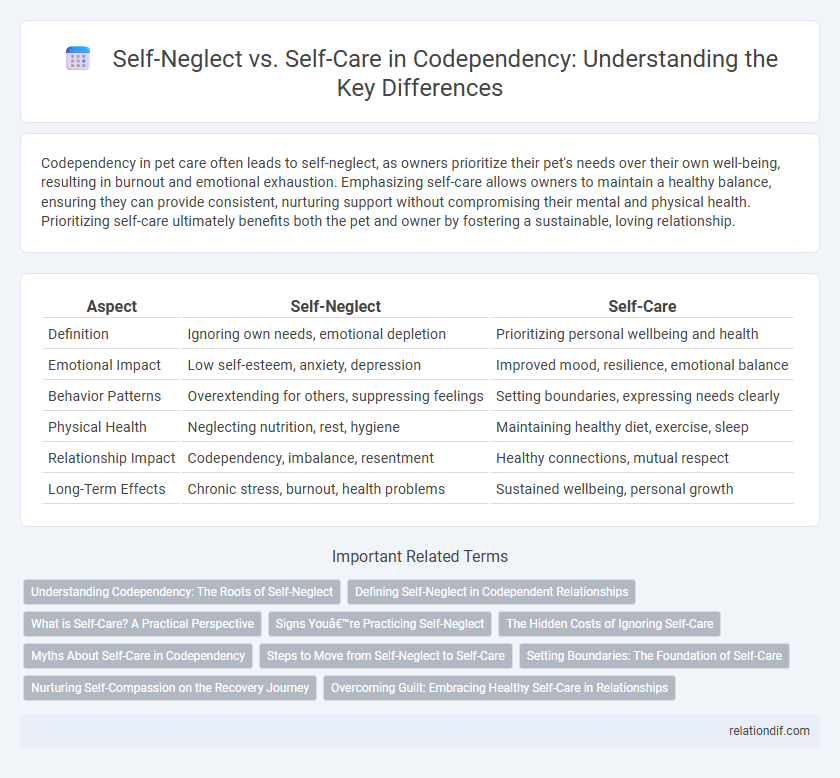Codependency in pet care often leads to self-neglect, as owners prioritize their pet's needs over their own well-being, resulting in burnout and emotional exhaustion. Emphasizing self-care allows owners to maintain a healthy balance, ensuring they can provide consistent, nurturing support without compromising their mental and physical health. Prioritizing self-care ultimately benefits both the pet and owner by fostering a sustainable, loving relationship.
Table of Comparison
| Aspect | Self-Neglect | Self-Care |
|---|---|---|
| Definition | Ignoring own needs, emotional depletion | Prioritizing personal wellbeing and health |
| Emotional Impact | Low self-esteem, anxiety, depression | Improved mood, resilience, emotional balance |
| Behavior Patterns | Overextending for others, suppressing feelings | Setting boundaries, expressing needs clearly |
| Physical Health | Neglecting nutrition, rest, hygiene | Maintaining healthy diet, exercise, sleep |
| Relationship Impact | Codependency, imbalance, resentment | Healthy connections, mutual respect |
| Long-Term Effects | Chronic stress, burnout, health problems | Sustained wellbeing, personal growth |
Understanding Codependency: The Roots of Self-Neglect
Codependency often manifests through persistent self-neglect, where individuals prioritize others' needs at the expense of their own well-being, creating an unhealthy imbalance. This pattern originates from deep-seated emotional dependencies and a diminished sense of self-worth, causing difficulty in setting personal boundaries and recognizing self-care. Understanding these roots is essential for breaking the cycle and fostering healthier habits of self-respect and emotional independence.
Defining Self-Neglect in Codependent Relationships
Self-neglect in codependent relationships manifests as the habitual disregard of one's own needs, emotions, and well-being to prioritize another person's demands or approval. This behavior often results in physical, emotional, and mental exhaustion, as individuals suppress self-care practices to maintain the relationship's perceived stability. Recognizing self-neglect as a core symptom of codependency is essential for developing healthier boundaries and fostering balanced self-care routines.
What is Self-Care? A Practical Perspective
Self-care involves intentional actions to maintain physical, emotional, and mental well-being, contrasting sharply with self-neglect common in codependency. Practically, self-care includes setting healthy boundaries, prioritizing personal needs, and engaging in regular activities that replenish one's energy and foster resilience. Recognizing and practicing self-care is essential for breaking codependent patterns and promoting long-term health and autonomy.
Signs You’re Practicing Self-Neglect
Persistent exhaustion, frequent illness, and ignoring personal boundaries are key signs you're practicing self-neglect within codependency. Overcommitting to others while disregarding your own emotional needs exacerbates stress and diminishes self-worth. Recognizing these patterns is crucial for shifting towards healthier self-care routines that foster emotional balance.
The Hidden Costs of Ignoring Self-Care
Ignoring self-care in codependency often results in chronic stress, emotional exhaustion, and deteriorating physical health. Persistent self-neglect undermines personal boundaries, leading to burnout and increased vulnerability to anxiety and depression. Prioritizing self-care is essential for restoring balance, improving mental resilience, and fostering healthier relationships.
Myths About Self-Care in Codependency
Myths about self-care in codependency often confuse self-care with selfishness, leading individuals to neglect their own needs to maintain codependent dynamics. Effective self-care involves setting boundaries, prioritizing personal well-being, and recognizing that attending to oneself is essential for healthy relationships. Dispelling these myths helps break the cycle of self-neglect common in codependent behaviors, promoting emotional resilience and balanced interpersonal connections.
Steps to Move from Self-Neglect to Self-Care
Recognizing the signs of self-neglect, such as ignoring physical and emotional needs, is the first crucial step toward embracing self-care. Establishing healthy boundaries, practicing mindfulness, and prioritizing personal well-being empower individuals to shift from patterns of self-neglect to nurturing self-care routines. Consistent commitment to these steps fosters emotional resilience and improved mental health, essential for overcoming codependency.
Setting Boundaries: The Foundation of Self-Care
Setting boundaries is the cornerstone of self-care, enabling individuals to protect their emotional well-being and prevent self-neglect commonly seen in codependency. Clear limits help maintain personal autonomy and promote healthy relationships by distinguishing one's needs from others' demands. Prioritizing boundary-setting fosters resilience and empowers individuals to practice consistent, intentional self-care.
Nurturing Self-Compassion on the Recovery Journey
Self-neglect in codependency often manifests as ignoring personal needs and prioritizing others' well-being, leading to burnout and emotional exhaustion. Practicing self-care involves setting healthy boundaries and engaging in activities that reinforce self-worth and healing. Nurturing self-compassion supports recovery by encouraging forgiveness, patience, and acceptance of oneself, fostering resilience and emotional balance.
Overcoming Guilt: Embracing Healthy Self-Care in Relationships
Overcoming guilt in codependency involves recognizing the importance of self-care without self-neglect, as prioritizing personal needs fosters emotional balance and healthier boundaries. Embracing self-care practices reduces enmeshment and promotes autonomy within relationships, cultivating mutual respect and emotional resilience. Consistent self-nurturing combats feelings of guilt by reinforcing the understanding that caring for oneself enhances the overall quality of relational dynamics.
Self-neglect vs Self-care Infographic

 relationdif.com
relationdif.com